Does OSHA Require Training for Aerial Lifts?
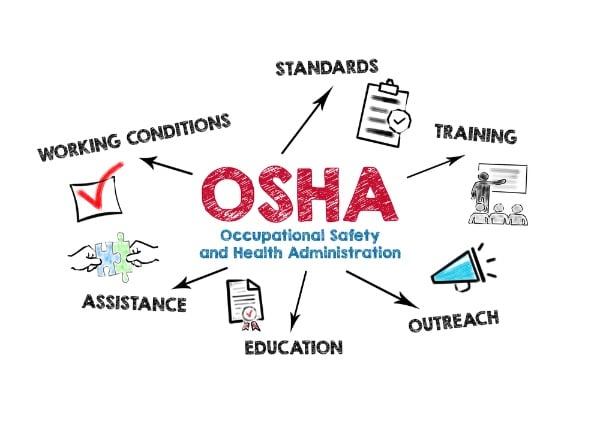
Mobile elevating work platforms (MEWPs) are large, complex, dangerous pieces of machinery that should never be used by an untrained operator. This is both a matter of safety and legal responsibility – OSHA has strict aerial lift training requirements for any personnel working around this equipment.
This guide covers OSHA and ANSI requirements for aerial lift operators, how to implement them in your workplace, and potential penalties for failing to meet standards. We also have a much more comprehensive aerial lift safety video if you want something to share with your employees and get them certified on this piece of equipment.
Does OSHA Require Aerial Lift Training?
The short answer is: yes.
OSHA has a series of training criteria that anyone operating an aerial lift should meet. Training should be appropriate to the type of aerial lift or MEWP being used; for example, a scissor lift requires different training from a boom lift.
OSHA aerial lift standards apply to:
- Extendable boom lifts
- Articulated boom lifts
- Aerial ladders
- Vertical towers
- Hybrid equipment combining features of these MEWPs
Only personnel who have received proper training may inspect, operate, or work using an aerial lift. If you want a list of aerial list safety tips that you can share with your employees we have that as well.
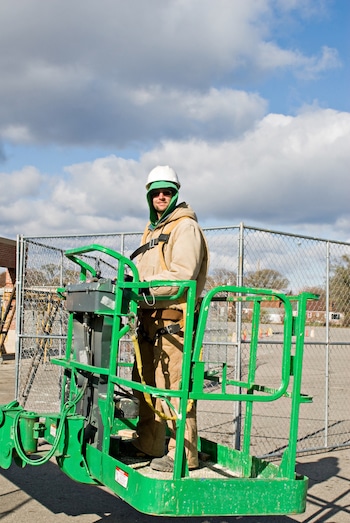
When Should Aerial Lift Operators Receive Training?
Training materials should be provided to MEWP operators before their first interaction with equipment, and refresher training should be provided annually for all operators.
Training is required even if an individual’s only job is to stand on an elevating platform. This is because MEWP training covers numerous subjects that all personnel should understand and have access to – staff members are also responsible for implementing OSHA standards.
Relevant standards for regular staff include:
- Understanding of fall protection systems
- Operating characteristics of the MEWP
- Appropriate behavior on elevating platforms
- Understanding of the frequency and consequences of workplace accidents
- How to identify and remove hazards related to the equipment
OSHA requires instructors or supervisors responsible for providing training programs and inspecting equipment to complete additional training.
This includes the OSHA 30 course and in-depth training on equipment inspections.
What is Required to Operate an Aerial Lift?
The OSHA training requirements for aerial lift operators and employees include:
- Identifying electrical safety hazards
- Understanding falling object safety hazards and fall risks
- Appreciation of unsafe ground conditions (e.g. a vehicle mounted on an uneven surface)
- Understanding and monitoring load capacity
- Bringing hazards to others’ attention and removing them where appropriate
- How to safely operate the aerial lift
- Recognizing the need for inspections
- How to check the manufacturer’s instructions and requirements
These regulations are non-exhaustive. OSHA and ANSI standards (American National Standards Institute) expect operators to provide training appropriate to the aerial lift in question.
Types of Aerial Lifts
OSHA aerial lift training requirements specify that training should be completed independently for each type of aerial lift. The safety knowledge needed to operate an aerial ladder, for example, is different from the knowledge required to operate a scissor lift.
Below are the most common aerial lifts found in the construction industry.
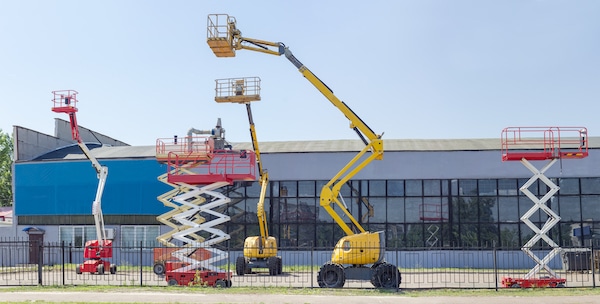
Boom Lifts
Boom lifts are frequently used on construction sites but also in diverse professions, from fire services to cherry pickers.
These aerial lifts may use an extending arm or an articulated (jointed) arm.
A boom lift reaches heights that most other aerial lifts are incapable of. Safe operation requires all individuals on the work platform to be trained and acutely aware of fall protection measures.
Likewise, the vehicle’s operation and inspection call for a unique skill set. Inspecting the boom arm and motor should follow a checklist, and any “failed” category should take the equipment out of service for safety reasons.
Checklists should follow both OSHA and ANSI standard safety regulations but also have respect for the manufacturer’s instructions and guidelines.
Scissor Lifts
Scissor lifts are aerial platforms that use an extending “scissor” mechanism to elevate the work platform; they’re commonly used in window cleaning and construction. As far as OSHA standards they are actually considered a scaffold.
The mechanism on a scissor lift is highly specialized and requires frequent inspections to ensure it’s fully operational. OSHA requires employers to provide scissor lift certification for any employees using this equipment.
Aerial Ladders
An aerial ladder is somewhat similar to an extending boom lift. Its most notable use is on fire trucks, and it mostly differs from booms in that it’s commonly vehicle-mounted.
While most aerial lifts are vehicles in some sense, aerial ladders may be attached to vehicles that move at high speeds, such as fire trucks.
The potential hazards of these ladders are somewhat different from other mobile elevating work platforms for this reason. OSHA safety standards generally stipulate that a vehicle shouldn’t move while employees are on the work platform.
However, the risks associated with a high-speed vehicle moving when employees are working at a height are significantly greater. The operation of both vehicle and ladder, therefore, requires specialized training and certification.
Vertical Towers
Vertical towers are hybrid types of aerial lift, somewhere between a scissor lift and a boom lift. The arm extends similarly to that of an extending boom, but like scissor lifts, they typically only move on a straight vertical axis.
So does scissor or boom lift certification allow employees to operate a vertical tower?
No.
Independent MEWP training is required for every different piece of equipment. Procedures are always different, and staff must be trained according to the equipment they’re contracted to use.
Other Aerial Lifts
Various types of other hybrid vehicles may be used in workplaces. OSHA regulations mandate that specialist training be provided for each vehicle.
This means that trainers must thoroughly check the manufacturer’s instructions and update inspection and training checklists appropriately. No certification is suitable for “all” MEWPs.
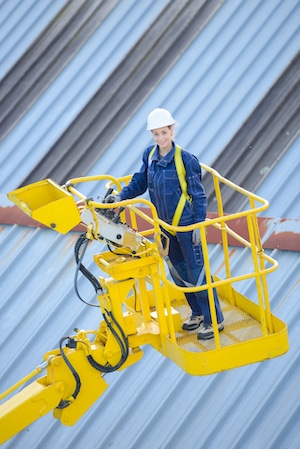
What Are the OSHA Aerial Lift Training Requirements For?
The purpose of aerial lift training is primarily to keep workers safe. Training requirements are divided into several key areas:
- Inspection
- Operation
- General use
A qualified person must inspect the equipment each day before use. The inspection covers the motor elements of the vehicle, the hydraulic arm, the platform, and the operator’s cabin.
Inspectors are typically highly trained professionals and may carry a higher level of certification than other employees. New and future hires are unlikely to be given inspection duties unless they have significant previous qualifications.
Operators (i.e. the individual driving the vehicle and operating the arm or platform) must also undergo specific training. It’s especially important that this type of OSHA aerial lift training is bespoke to the MEWP being used.
MEWP operators should undergo a trainer course before entering the cabin of a vehicle. Only authorized persons should be allowed to sit at the controls, as the safety of other workers could be put at risk otherwise.
General personnel should be well-versed in safety procedures, identifying hazards, and PPE required when working on a MEWP.
PPE (e.g. hard hats) required for platform work should be readily available to staff, and staff should also know when to flag insufficient safety protocols to a supervisor.
What OSHA Regulation Covers Aerial Lifts?
OSHA aerial lift training requirements follow ANSI standards for “Vehicle Mounted Elevating and Rotating Work Platforms.” Further information is provided in OSHA standard 1926.
The essential information for operating an aerial lift safely can be taught and digested within about an hour. Employees aren’t required to quote OSHA regulations chapter and verse – the point is that safety standards are described, understood, and followed.
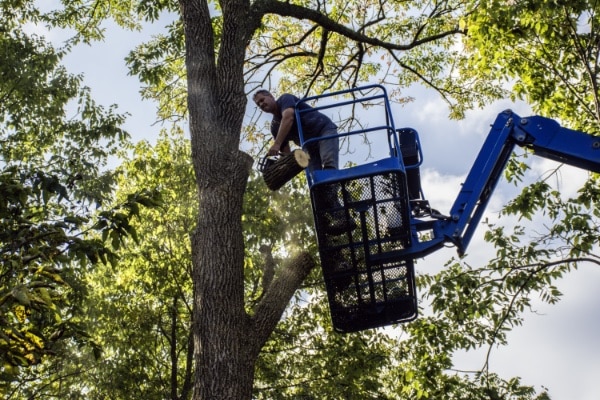
Who Needs to Obtain OSHA Certification?
“OSHA certification” is a slightly confusing term. Employees working around MEWPs should have completed the OSHA 10 training program outlining essential workplace safety.
Further training specific to the MEWP provides a license to operate the vehicle. This typically lasts for three years, although some employers require annual renewal.
Supervisors responsible for giving new employees a trainer course should typically have completed the OSHA 30 qualification.
While this is a type of certification, there is no comprehensive “OSHA certification” for trained aerial lift operators. Each MEWP comes with a license once the individual has passed the training module.
When operators complete the training materials, their knowledge is tested by an exam – passing this qualifies them to work with relevant aerial lifts while on company property.
Who is Responsible for Providing OSHA Aerial Lift Training Requirements?
A qualified person who has passed the OSHA 30 exam and has been designated as a workplace safety officer should provide training programs for new hires. They should also provide annual retraining for all staff.
Training may be provided in person or through OSHA-approved training videos. These are often preferable for several reasons:
- Staff can watch the videos on their own time
- For experienced staff learning about new machinery, “generic” sections (e.g. the importance of wearing hard hats) that apply to all MEWPs can be skipped. Instead, they can focus on technical differences between vehicles
- There’s no risk that the instructor forgets anything
- If one staff member misses a training day, there’s no need for the instructor to schedule an extra training session
- Many workers don’t respond well to classroom environments
- Videos are cheaper than paying experienced staff to provide instruction
OSHA-approved videos are widely considered the best method for OSHA aerial lift training. Videos are available for aerial and scissor lifts and numerous other MEWPs.
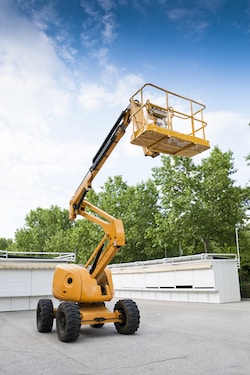
Penalties for Letting Untrained Personnel Operate Aerial Lifts
Aerial lift operation should only ever be performed by qualified personnel. Aerial work platforms carry numerous risks even when safety procedures are properly followed. Untrained personnel using this type of equipment can easily have fatal consequences.
If companies don’t ensure safety procedures are followed for any type of aerial lift equipment, they may face fines from federal and local authorities.
Fines may start at around $1,000 and rise to over $13,000 per violations. Repeat violations may incur even larger penalties.
Individuals in charge of an unsafe or unsupervised work environment may also face criminal charges if an accident occurs. It is in every company’s best interests to ensure that OSHA aerial lift standards are consistently met and that adequate training is provided to all staff.
Does OSHA Require Aerial Lift Inspections?
OSHA requires several types of equipment inspections for aerial work platforms. These include:
- Daily inspections. These are performed before equipment is used on any given day. These inspections are designed to check that the vehicle is operating properly and there are no safety hazards. Any failed checks must be reported and the equipment should be taken out of service until it is repaired.
- Frequent inspections. These are performed every three months. This is an in-depth inspection that especially examines the motor and hydraulic functions of the lift. It goes into greater detail than a daily inspection could. The specific frequency for these inspections is after 150 hours of use or after three months – the earlier date should be used.
- Annual inspections. These are performed by an external engineer. Every MEWP must receive annual inspections to ensure it’s in good working order. If the lift fails this inspection, it must be returned to the manufacturer for servicing.
When Should You Perform an Aerial Lift Inspection?
Daily inspections should be performed by a qualified, experienced member of staff. The inspector is usually a supervisor with specific knowledge of how the lift works and with reference to the manufacturer’s manual.
Routine inspections must be performed by a qualified aerial lift mechanic.
The annual inspections are performed by a specialist qualified mechanic or engineer, often contracted by the lift’s manufacturer.
Only the daily inspections may be performed by an individual who isn’t a qualified aerial lift mechanic.
OSHA Aerial Lift Training Requirements for Inspectors
The member of staff responsible for daily inspections should be an experienced individual but need not be a professional mechanic. They should hold a license for the MEWP they are inspecting and consult a checklist to ensure every part of the equipment is fully functional.
Summary
Employers wondering “does OSHA require training for aerial lifts” should be aware that OSHA is extremely strict about aerial lift safety violations. It’s highly recommended that employers implement high-quality, OSHA-approved training videos to ensure all employees are well-informed.
Separate training should be provided for each MEWP in service. All staff should be provided with training, whether they’re standing on the platform or operating the vehicle.
Diligence saves lives, and compliance saves companies from significant fines. There’s every reason to implement OSHA-approved aerial lift training in your workplace today.